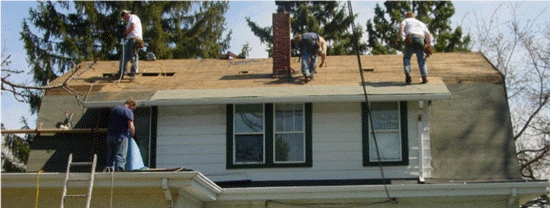Massachusetts Home Inspections YOUR INVESTMENT IS MY CONCERN

Roofs

There are many different roof types, and every roof will wear differently relative to its age, the number of its layers, the quality of its material, the method of its application, its exposure to direct sunlight, or to other prevalent weather conditions, the required ventilation and its periodic maintenance. However, regardless of its design-life, every roof is only as good as the waterproof membrane beneath it, which is concealed and cannot be examined without removing the roofing material itself, and this is equally true of almost all roofs. In fact, the material on most pitched roofs is not designed to be waterproof, it's simply water-resistant.
There are two basic roof types in Massachusetts, pitched and flat. Pitched roofs are the most common, and the most dependable. They are variously pitched, and typically finished with composition shingles that have a design life of eighteen to thirty years (depending upon quality of the shingle and the environment), or wood shakes/shingles that have a design-life of forty to fifty years, and roll roofing that have a lesser pitch and a shorter design-life of ten to fifteen years. These roofs may be layered, or have one roof layer installed over another, which is common practice but one that I never recommend because it reduces the design-life of the new roof by several years and requires a periodical service of all penetration flashings. Failing (leaking) flashings are typically upgraded with mastic, which eventually shrinks and cracks and provides a common point of leakage (again) if not properly maintained on an annual basis.
However, among the pitched roofs, roll roofing is the least dependable, because the low pitch prevents them from draining as readily as other roofs. For this reason, they must be conscientiously maintained. In this respect, the least dependable of all roofs are the flat roofs, due to water retention and the suns rays beating down on this surface daily. There are many materials used for flat roofs today but the most popular material is Rubber (EPDM). Rubberized and PVC roofs are becoming the ultimate material for flat roofs today, as they have a life expectancy of 25-30 years with proper installation and maintenance. Some flat roofs are adequately sloped toward drains but many simply are not, and any water build-up will simply pond and will only be dispersed by evaporation. These puddling areas also collect debris and do not get maintained as regularly as they should. They also tend to wear more rapidly than areas that drain properly. However, the most common causes of leakage (on flat roofs) results when roofs are not serviced or kept clean, and foliage and other debris blocks the drainage channels. Please see "Roof Maintenance".
What remains true of all roofs is that, whereas their condition can be evaluated, it is virtually impossible for anyone to detect a leak except as it is occurring or by specific water tests, which are beyond the scope of my home inspection service. Even water stains on ceilings, or on the framing within attics, will not necessarily confirm an active leak without some corroborative evidence, and such evidence can be deliberately concealed. Consequently, only the installer of the roofing material can credibly guarantee that a roof will not leak, and most do.
Massachusetts Home Inspections cannot, and does not give any such roof guarantees. I will examine every roof, evaluate it, and even attempt to approximate its age, but I will not predict its remaining life expectancy, nor guarantee that it will not leak. Naturally, the Sellers or the occupants of a residence will generally have the most intimate knowledge of the roof and of its history. Therefore, I recommend that you ask the Sellers about their roof. I recommend that you either include comprehensive roof coverage in your home insurance policy, or that you obtain a roof certification from an established local roofing company.
ROOF VENTING
Proper roof venting is critical to good construction practices and maintenance. The purpose of roof venting is to reduce temperature build-up inside the roof cavity during the summer months. If an attic cavity is not properly ventilated, the shingle life can be cut in half and ventilation reduces fungal wood rot and other problems associated with condensation in the roof cavity during the cold winter months.
A good venting system allows for a continuous flow of air which enters the roof cavity at a low spot in the roof (for example, soffit vents installed under the eave) and exits the roof at a high spot (for example, a ridge vent installed at the ridge of the roof). As a general rule, there is no need to provide for any sort of mechanical assistance, fans, or other devices to the roof venting system. A good venting system works adequately by means of a natural convection current where warm air rises and pulls the cooler (drier air) behind it. A good roof venting system must also be designed in such a way as to provide for proper air flow at all portions of the roof. As I stated above, improperly vented roofs often result in premature deterioration of the roofing material and fungal wood rot in the roof framing and sheathing. See "Ventilating Your Attic" for an illustrated version of properly venting your attic.
It is not uncommon to find an improperly vented fifteen-year-old roof with badly cupped (and thus non-functional) roofing material and advanced fungal wood rot on the attic side of the roof sheathing. With the introduction of more insulation (R-Value) and tighter weather sealing, as well as other building techniques which reduce building ventilation, proper roof venting techniques are even more critical now than it was in the past.
Most importantly, never cover up your attic vents in the winter as this the most important time proper ventilation is needed. If you feel cold air coming into your living area from your attic, it's possible that additional insulation is needed on the floor surface of the attic and at the interior access opening of the attic. Again, do not cover the required attic vents and keep all of the attic vents screened to prevent insects and rodents from gaining access to this cavity.
MY ROOFING DEFECTS ARE POSTED ON FACEBOOK...
Here is what my clients have to say about my home inspection services:
Press F5 (on your keyboard) for additional testimonials
I recently accompanied David Valley during his inspection of the house my son was buying. Having purchased a number of houses during my lifetime, I considered myself very knowledgeable and thorough. However, he surpassed me greatly, picking up on important details I would have missed. He frequently suggested ways on how something could be fixed or improved. He displayed broad knowledge of house structure, heating and cooling system, plumbing, electrical, etc. David is the best home inspector I have ever employed and I recommend him implicitly. Thank you for a great home inspection.
Sincerely yours,
Hartmut S.
















